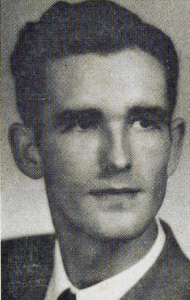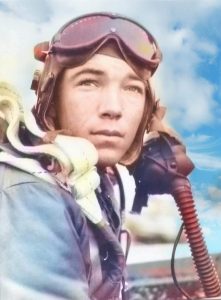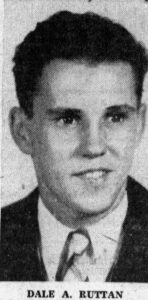Stuart Waller King, age 47, from Pinellas County Clearwater, Florida .
Spouse: Mary L. King
Service era: World War II
Date of death: Sunday, December 31, 1944
Death details: On December 13, 1944, Japanese forces in the Philippines began the transfer of 1,621 Allied prisoners of war (POWs) to Japan. The POWs were to make the journey aboard transport ships whose harsh conditions and extreme overcrowding led survivors to refer to them as “Hell Ships.” The ships also lacked markings that would distinguish them from any other military target, causing some of them to be attacked by Allied forces who could not identify them as POW transports. On December 14, 1944, Allied aircraft attacked the first ship, the Oryoku Maru, in Subic Bay in the Philippines, killing many Allied POWs who became lost in the water, sank with the ship, or were washed ashore. Survivors of the bombing were put aboard two other ships, the Enoura Maru and the Brazil Maru, to continue on to Japan. During the journey, while anchored in Takao Harbor, Formosa (present-day Taiwan), the Enoura Maru was attacked by Allied aircraft from the USS Hornet (CV-8), killing Allied POWs who were lost in the water, on board the ship, or on the nearby shore. Survivors of the Enoura Maru bombing were loaded onto the Brazil Maru, and reached Japan on January 30, 1945. As a result of these incidents, Allied POWs were lost in the Philippines, at sea between the Philippines and Taiwan, while anchored in Taiwan, at sea between Taiwan and Japan, and in Japan. The attacks on these POW transports ultimately resulted in a series of death notifications from the Japanese government through the International Red Cross (IRC), and some casualties were given up to five different dates of death at various locations during the transfer. Witness accounts from surviving POWs offer detailed information for a handful of casualties, but the specific dates of loss and/or last-known locations for many of these POWs are based on the most recent reported date of death. Lieutenant Colonel Stuart Waller King, who joined the U.S. Marine Corps from Virginia, served in Headquarters Company, 4th Marine Regiment, in the Philippines during World War II. He was taken as a prisoner of war by the Japanese following the American surrender in the Philippines, and was held on the islands until December of 1944, when he was put aboard the Oryoku Maru for transport to Japan. Records indicate LtCol died several weeks later as a result of wounds he suffered during the attack on the Enoura Maru, and was buried at sea; however, these reports often involve information solely furnished by enemy governments, with some casualties given multiple date sof death. Future research may determine that these reports were inaccurate. His remains have not been recovered, and he is still unaccounted-for. Today, Lieutenant Colonel King is memorialized on the Walls of the Missing at the Manila American Cemetery in the Philippines.
Source: National Archives, Defense POW/MIA Accounting Agency, Tampa Bay Times (1946)
 Death details: On July 11, 1950, the U.S. Army’s 21st Infantry Regiment, which had arrived in Korea six days earlier, was placed in defensive positions near the town of Chochiwon, South Korea. The regiment was not at full strength and lacked artillery and anti-tank weapons. That day, they were attacked by North Korean forces and were forced to withdraw to avoid being surrounded, as well as to buy time until they could be reinforced and resupplied. Sergeant Kenneth Brandenburg, who joined the U.S. Army from Ohio, served with B Company, 1st Battalion, 21st Infantry Regiment, 24th Infantry Division. He was taken prisoner of war on or about August 11, 1950, near Chochiwon, South Korea. After his capture, he was marched to prison camps in North Korea, and died of exposure, malnutrition and pneumonia at a camp near Manpo, on or before October 31, and was buried nearby. His remains were not identified among those returned to U.S. custody after the war. Today, Sergeant Brandenburg is memorialized on the Courts of the Missing at the National Memorial Cemetery of the Pacific.
Death details: On July 11, 1950, the U.S. Army’s 21st Infantry Regiment, which had arrived in Korea six days earlier, was placed in defensive positions near the town of Chochiwon, South Korea. The regiment was not at full strength and lacked artillery and anti-tank weapons. That day, they were attacked by North Korean forces and were forced to withdraw to avoid being surrounded, as well as to buy time until they could be reinforced and resupplied. Sergeant Kenneth Brandenburg, who joined the U.S. Army from Ohio, served with B Company, 1st Battalion, 21st Infantry Regiment, 24th Infantry Division. He was taken prisoner of war on or about August 11, 1950, near Chochiwon, South Korea. After his capture, he was marched to prison camps in North Korea, and died of exposure, malnutrition and pneumonia at a camp near Manpo, on or before October 31, and was buried nearby. His remains were not identified among those returned to U.S. custody after the war. Today, Sergeant Brandenburg is memorialized on the Courts of the Missing at the National Memorial Cemetery of the Pacific.

